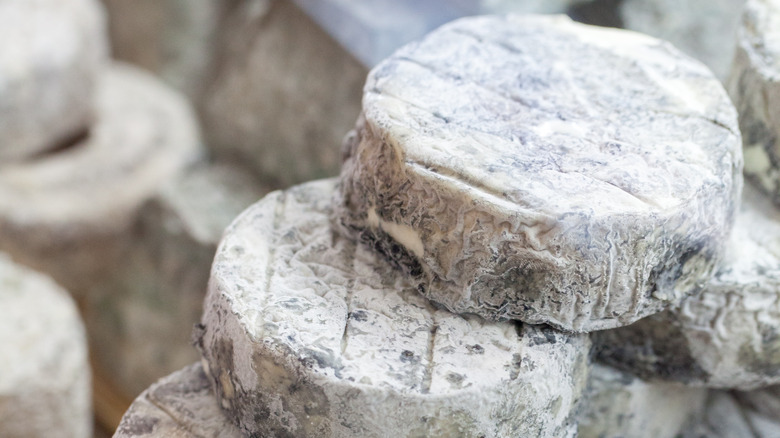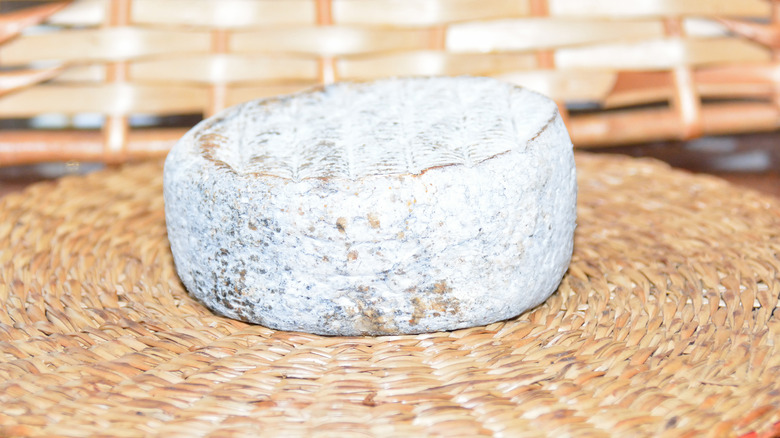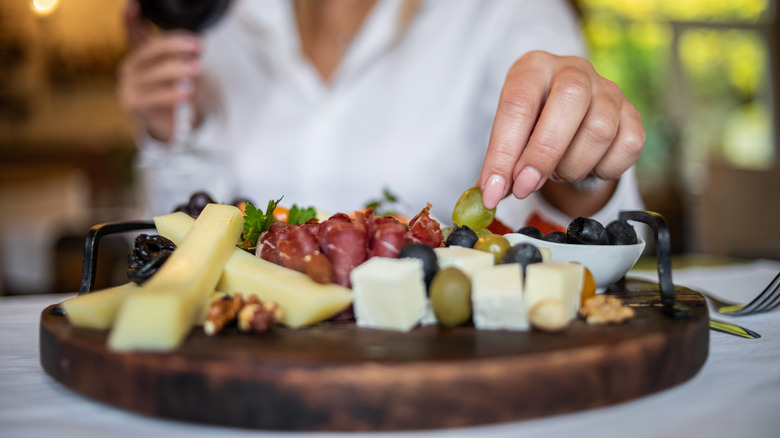Ash-Ripened Cheese Is More Than Meets The Eye
From raw milk cheese to pungent, odorous fromages, skeptics have all sorts of cheese-related hang-ups. But, if you aren't thinking "yum" when you hear the words "ashy cheese," it might be time to think again.
For starters, ash-ripened cheese looks visually unique. It can manifest as a black, gray, or blue stripe through the center of the wheel, or as a more subtle hue on the rind. With the aesthetic contrast of a dark line of ash against a creamy white cheese, you'll never have to wonder whether you're looking at a block of ash-ripened cheese.
But, visuals aren't the only reason why cheesemongers started ashing their wheels. On the functional level, ash-ripening aids in the formation of curds, speeds up the ripening process, and balances flavor. The combination of salt and ash forms an alkaline solution that attracts penicillium candidum bacteria, which is instrumental in the formation of flavor. As such, the alkalinity of the ash slightly neutralizes cheese curds' natural acidity. Bermuda Triangle, for instance, is a California-made pasteurized goat milk in the Brie family. Typically, Brie is mild yet pungent with a smooth creaminess. But, Bermuda Triangle cheese is shaped into a triangular brick, then layered in black ash and cold-stabilized for a few days to ripen. The resulting flavor is a tart, tangy, and peppery ripple.
Tradition meets modern food science
Whether or not you've heard of it before, ash-ripening cheese is a centuries-old practice. The technique might have been originally invented as a way to protect the vulnerable surface of young cheeses by repelling insects, stopping harmful microbes from growing, and keeping moisture at bay. But, to ancient cheesemongers' pleasant surprise, ash also helped facilitate the growth of good flavorful surface molds as cheese ripened. Sprinkling ash on top of the cheese before it could develop a rind meant that cheesemongers could leave the kitchen to milk their cows a second time, and then add another layer of curds on top before the finished batch was encased in a rind.
Early cheesemongers used to use ash directly from fires and grapevine ash was commonly used with the soft goat cheeses of France's Loire Valley. Today, the types of ash used in cheesemaking are odorless, flavorless, and food-grade (aka sterile). Vegetables are often dried and turned into ash, and other types of ash include a combination of salt and activated oak charcoal.
How to enjoy ash-ripened cheese
Today, there's a wide array of foreign and domestic ash-ripened cheeses for foodies to try. Perhaps the most widely known is Morbier, a semi-soft, unpasteurized cow's milk cheese from France. Selles sur Cher, Saint Maure, and Valencay are other popular French varieties. America is home to many ash-ripened cheeses as well, like Bonne Bouche, Wabash Cannonball, Beekman 1802 Blak, Humboldt Fog, and more.
Trying out ash-ripened cheese is a great excuse to visit your local cheesemonger. It makes an impressive, sophisticated addition to your next charcuterie board (dinner party guests are already swooning). But, it's also accessible — enjoy its smoky flavor at outdoorsy events like camping trips and backyard barbecues.
To really lean into the smokiness of the ash-ripened cheese, you could assemble your charcuterie board with lox, smoked cream cheese, black pepper crackers, andouille sausage, spicy olives, capers, and grainy mustard. Then, to finish, pair it with a complementary wine like Chardonnay.


